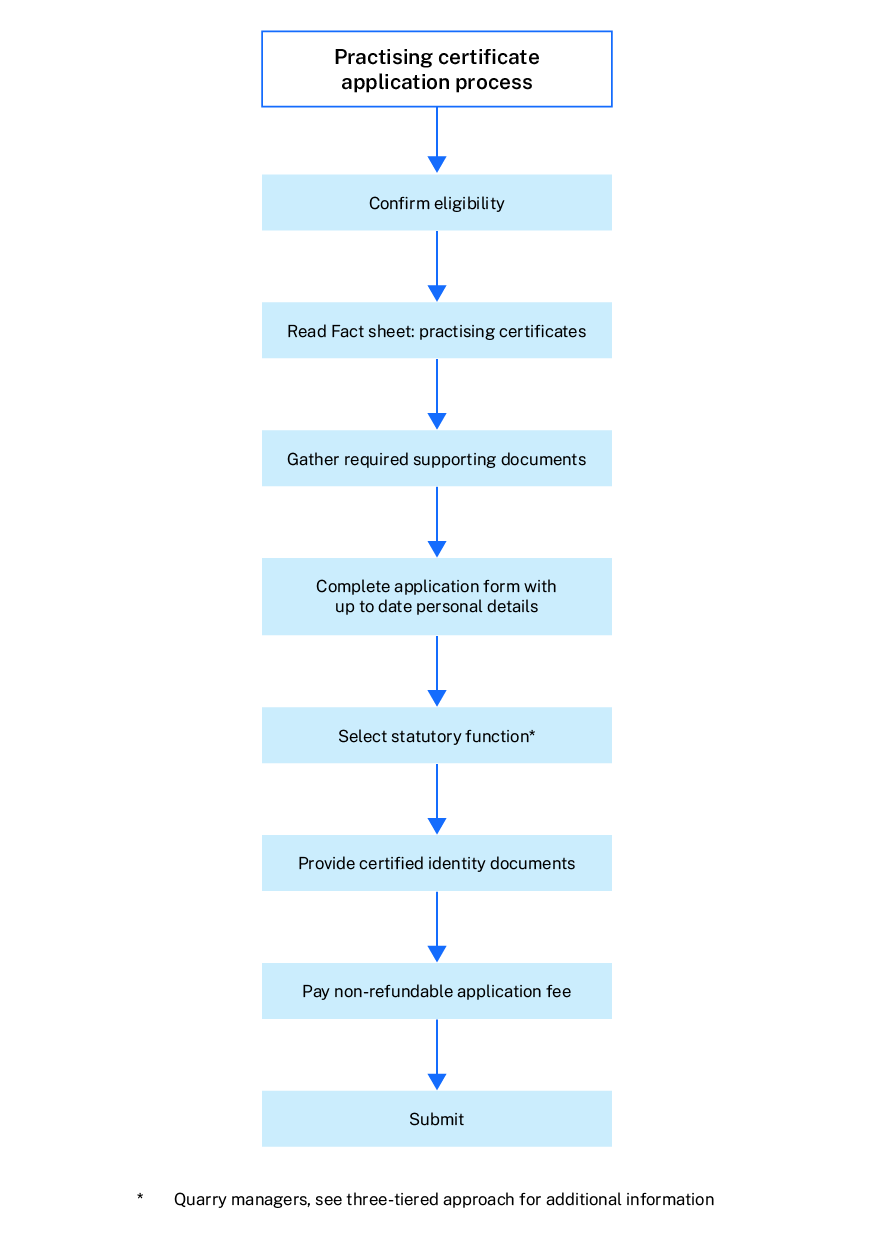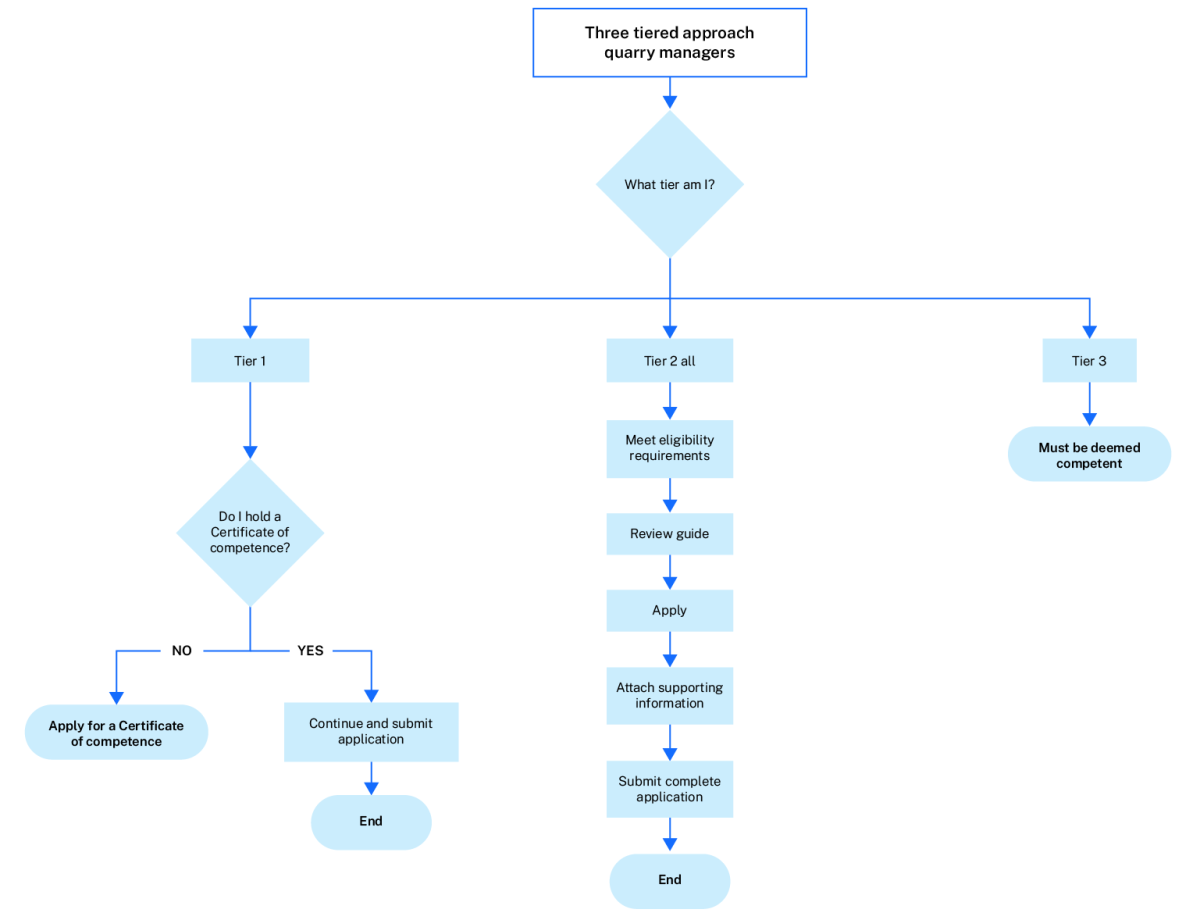Practising certificates application process
Learn how to apply or renew a practising certificate. And how we determine whether you are competent to be issued with a certificate or can gain mutual recognition for interstate or NZ certificates.
Completing your application
For the best user experience, we recommend using a desktop or laptop computer to complete your application.
Regulator Portal
Practising certificate fee schedule
New, renew, vary, revoke, mutual recognition and certificate replacement
Practising certificate fee schedule (PDF, 77.25 KB)
New practising certificate application
There are several steps involved in applying for a new practising certificate.
Note: different requirements and fees apply for different tiered Quarry managers.
Applications are submitted via the Mining Worker's section of the Regulator Portal. They can take between 2 to 6 weeks to process, depending on your application and the total number received.
Note: All documentation and identity verification submitted during the application process must meet the Regulator’s requirements. For detailed information, please refer to the Fact Sheet: Certifying documents (PDF, 83.58 KB).
It is important to keep your details up to date when applying for or renewing a practising certificate. This aids with communication, whereby the regulatory body needs accurate contact information to send you important notifications, reminders about renewal deadlines, and other critical updates regarding your practising certificate and regulatory matters.
Note: payment of the application for a fee for a new practising certificate must be made with the submission of your completed application in the Regulator Portal for it to be accepted and progressed. The application fee* is non-refundable if your application is incomplete, unsuccessful or if you withdraw. Payments are made through the third-party payment gateway, Humanitix.
*Please ensure you are paying the correct practising certificate fee.

Quarry managers practising certificates
The NSW Resources Regulator uses a three-tier system approach for quarry manager practising certificates:
- Tier-1: quarry manager Practising Certificate attained on basis of holding Certificate of Competence.
- Tier-2: quarry manager Practising Certificate.
- Tier-3: competent person (no practising certificate required).
Read the Fact sheet: Quarry Managers Practising Certificates 3-tier approach (PDF, 108.09 KB) to understand what tier may apply at the quarries at which you want to exercise the statutory function. The tier of the quarry will determine how you apply for a practising certificate. The following diagram aims to give an overview of the different options pertaining to each tier.
Note: payment of the application fee for Quarry Manager Tier 2 All*, must be made with the submission of your completed application in the Regulator Portal for it to be accepted and progressed. The application fee is non-refundable if your application is incomplete, unsuccessful or if you withdraw.
*Please ensure you are paying the correct practising certificate fee

Quarry managers resources and guides
- Supporting information application form (DOCX, 131.04 KB)
- Fact sheet: Certifying documents (PDF, 83.58 KB)
- Guide: Quarry manager tier 2 with conditions (PDF, 159.62 KB)
- Fact sheet: Quarry manager 3 tier approach (PDF, 108.09 KB)
- Risk profiling tool (DOCX, 860.43 KB)
- Small mines and quarries
Quarry manager risk profiling tool
Risk profiling tool
The Mining and Petroleum Competence Board has developed, in collaboration with the NSW Resources Regulator and industry representatives, a risk profiling tool (DOCX, 860.43 KB) that enables the user to calculate a mine’s hazard burden and help determine the certificate requirements or not for nomination as the quarry manager.
The tool assesses the mine’s principal hazards, activity levels, mechanical and electrical complexities, staffing and output levels and generates a numeric output. The output is then compared against a predetermined measure to establish the certificate required to be held by the nominated quarry manager.
Risk profiling tool result – what does it mean?
A mine must nominate a person to be the quarry manager. When, after using the risk profiling tool, the numeric output for the mine is above the pre-determined measure, the mine operator must nominate a person with a practising certificate. The Regulator recognises and will allow, in certain circumstances, a person with a practising certificate with conditions to be the quarry manager during a period of transition. After that time the mine must nominate a person with a practising certificate.
If the numeric output is below the pre-determined measure, the mine operator can nominate a quarry manager with a practising certificate or a practising certificate with conditions, for their mine(s). Note: tier 3 quarries do not require a person to hold a practising certificate but only to be a competent person
If the numeric output is in close alignment with the predetermined measure (+/- 5 points), consultation between the Regulator and the mine operator may be required.
The profiling tool can also be used by the mine operator for succession planning purposes, with the result incorporated into their statutory quarry manager planning requirements. In this instance, there is no requirement to notify the Regulator of the result.
Using the tool
Before the submission of an application for a practising certificate, the risk profiling tool should be used by the mine operator to determine the eligibility of their quarry for what tier level certificate is required (1 or 2) or no certificate (3). Alternatively, the Resources Regulator may have already notified the mine operator of what tier their quarry is or the mine operator can check with the Regulator (see Further information below)
The Resources Regulator will complete an assessment using the risk profiling tool to confirm eligibility for any Quarry manager with conditions tier 2 location specific practising certificate.
The Regulator can use the risk profiling tool:
- during a desktop assessment where mine data is well understood
- during any site inspection
- during the application process for a practising certificate. In this instance, consultation with the mine operator may be necessary
- when the 5-year life of a practising certificate is due for renewal to determine a mine’s hazard burden.
Mutual recognition of interstate or New Zealand certificates for WHS statutory functions
Applying for mutual recognition of an interstate or New Zealand certificate to obtain a practising certificate or Automatic Mutual recognition to carry out the equivalent occupation in NSW. Note that qualifications prescribed for statutory functions are not recognised as a certificate.
Depending on where your principal place of residence and work is, the holder of a statutory certificate can notify the Resources Regulator for registration in two different ways under the provisions of the Mutual Recognition (NSW) Act 1992 for Australian states or territories, or the Trans-Tasman Mutual Recognition (NSW) Act 1996 for New Zealand.
Regardless of the type of mutual recognition you obtain, all interstate workers must comply with NSW regulations and codes while working in NSW. This includes maintenance of competence.
Substantive registration (NSW practising certificate issued)
If you are or intend to have your principal place of residence and work in NSW:
- You must notify/apply and pay a fee for a NSW practising certificate for the equivalent WHS statutory function that your interstate or NZ certificate enable you to carry out
- While waiting on approval of your application you can practise in the equivalent occupation(s) for up to 30 days (if application is refused then a mine operator can no longer nominate you to carry out the function)
- If granted mutual recognition in NSW, a practising certificate will be issued for five years (or a shorter period if determined by the Resources Regulator)
- Your practising certificate is subject to the condition requiring participation in the maintenance of competence scheme.
For further information on substantive mutual recognition for statutory functions read Fact sheet: Notification of mutual recognition of statutory standards (PDF, 255.48 KB)
Automatic Mutual Recognition – AMR (electronic registration only)
You are required to do maintenance of competence on a pro rata basis of how long you temporarily work in NSW against the 5 year period requirements of a NSW practising certificate. Please notify Service NSW.
Privacy statement – Automatic mutual recognition
The Resources Regulator acts a Local Registration Authority (LRA) as part of the AMR program and thus certain personal information is required.
This information may be used to:
- Verify registration status (with consent)
- Audit maintenance of competence compliance
- Support compliance and enforcement activities
For further information on how we manage your information and privacy please refer to Managing your information – Automatic Mutual Recognition.
Note: mining occupations are no longer exempt from AMR.
Additional resource: Fact sheet: Mine operators managing workers under automatic mutual recognition (PDF, 88.66 KB)